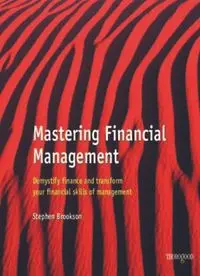
Mastering Financial Management: Demystify Finance and Transform Your Financial Skills of Management (Masters in Management) PDF
Preview Mastering Financial Management: Demystify Finance and Transform Your Financial Skills of Management (Masters in Management)
Mastering Financial Management Demystify finance and transform your financial skills of management Stephen Brookson IFC Mastering Financial Management Demystify finance and transform your financial skills of management Blank page Mastering Financial Management Demystify finance and transform your financial skills of management Stephen Brookson Published by Thorogood Ltd 12-18 Grosvenor Gardens London SW1W 0DH 0171 824 8257 A catalogue record for this book is available from the British Library ISBN 1 85418 067 3 (Trade edition) ISBN 1 85418 101 7 © Stephen Brookson 1998 All rights reserved. No part of this publication may be reproduced, stored in a retrieval system or transmitted in any form or by any means, electronic, mechanical, photocopying, recording or otherwise without prior permission of the copyright holder. Printed in Great Britain by Ashford Colour Press The author Stephen Brookson Stephen Brookson is Managing Director of his company, New City Consulting, which specialises in the provision of practical business development consultancy and training programmes. He qualified as a Chartered Accountant in 1980 with Peat Marwick and after a period at Grandmet plc, he joined a leading organisation in the provision of training for chartered accountants in practice. During this time he gained extensive experience of writing, developing and presenting programmes on accountancy and taxation. He then joined Ernst & Young for a number of years as a consultant, leaving them to set up his own management and training consultancy business. He has presented numerous seminars and training events in both the public and private sectors, in the UK and overseas. Blank page 1 Contents Icons....................................................................................................11 Chapter 1: Finance makes the world go round..........................................13 Who this is for ......................................................................................14 You are not alone ............................................................................14 Overview ..............................................................................................15 Other sources..................................................................................15 Users and uses of financial information ..............................................16 Financial versus management accounting ............................................17 Name that accountant......................................................................18 Rules governing accounting....................................................................20 Law ..............................................................................................20 Accounting standards ......................................................................20 International dimension ..................................................................24 Big GAAP/Little GAAP ......................................................................24 Corporate financial health......................................................................25 Audits ..........................................................................................25 Corporate reality ............................................................................25 SSAP 2..................................................................................................25 1 Accruals (or matching) concept ......................................................26 2 Going concern..............................................................................27 3 Consistency ................................................................................27 4 Prudence ....................................................................................28 Basic accounts ......................................................................................28 Profit and loss account ....................................................................29 Balance sheet ......................................................................................34 The two business cycles....................................................................35 Fixed assets....................................................................................35 Cost ..............................................................................................36 Revaluations ..................................................................................36 2 M A S T E R I N G F I N A N C I A L M A N A G E M E N T Depreciation ..................................................................................38 Depreciation method........................................................................40 Notes to accounts ..........................................................................43 Current assets and current liabilities ......................................................44 Current assets ................................................................................44 Working capital example ..................................................................46 Current liabilities ............................................................................48 Ratio analysis ................................................................................48 Other current liabilities ....................................................................50 Critical issues ................................................................................50 Long-term liabilities ............................................................................51 Creditors due after more than one year ..............................................51 Historical cost ................................................................................51 Balance sheet summary ....................................................................52 Other side of the balance sheet ..............................................................52 Chapter 2: Analysing performance ...............................................................55 Interpreting accounts using ratio analysis ..............................................56 Introduction ..................................................................................56 Return on capital employed (ROCE) ....................................................56 Tree of ratios ..................................................................................58 Profitability measures ..........................................................................59 Earnings per share (EPS) ..................................................................60 Balance sheet measures ........................................................................61 Asset turnover ................................................................................61 Fixed asset turnover ........................................................................61 Debtor days ....................................................................................62 Stock days......................................................................................63 Creditor days ..................................................................................63 Current ratio ..................................................................................63 Quick ratio ....................................................................................64 Stock to net assets ..........................................................................65 Stock turnover ................................................................................65
